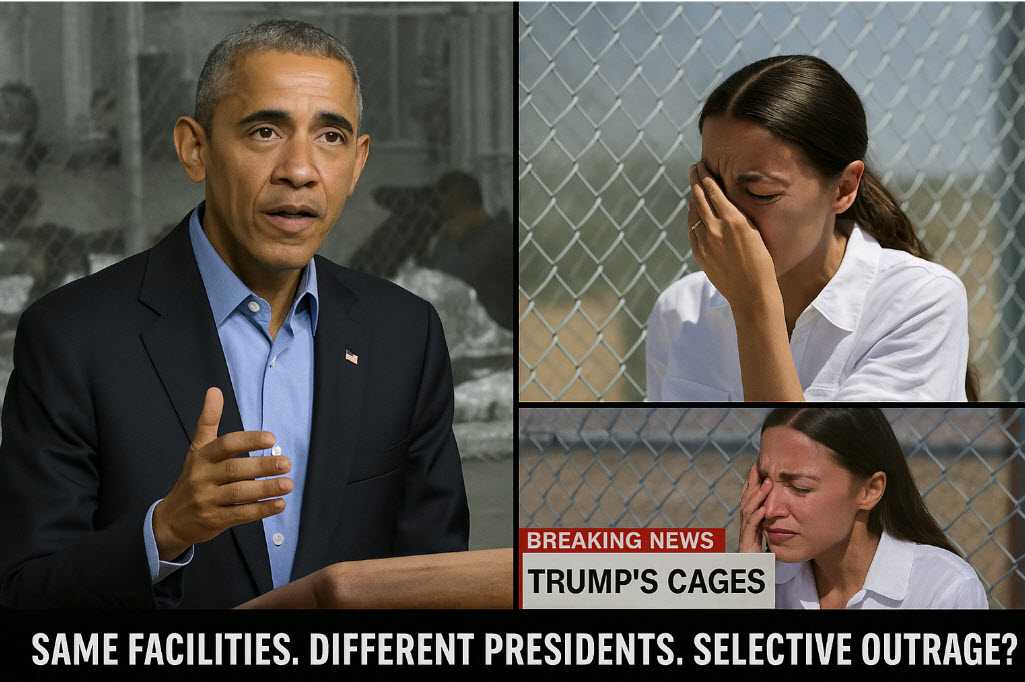In the heat of America’s border crisis debates, one image captured the public’s imagination and outrage: children behind chain-link fences, lying under Mylar blankets, crying and bewildered. These images were circulated endlessly on social media and in major newspapers, accompanied by incendiary headlines accusing the Trump administration of jailing children and tearing them from their families. The narrative became so entrenched that the phrase “kids in cages” entered the political lexicon as shorthand for cruelty, xenophobia, and what some even claimed was fascism. Yet this simplified moral tale was built on a false foundation.
The phrase “kids in cages” was deliberately crafted to evoke horror, but it omitted essential context: the same detention facilities had been built during the Obama administration in response to a surge in unaccompanied minors crossing the border. Legal precedents, humanitarian concerns, and logistical necessities made it impossible to detain children and adults together indefinitely. Under President Trump, a “zero-tolerance” policy led to more prosecutions for illegal entry, which in turn led to more family separations—but within the bounds of law and consistent with longstanding immigration enforcement practices.
The political Left weaponized the optics of child detentions, relying on an uninformed public and a willing media to distort reality. Meanwhile, under President Joe Biden, a much larger humanitarian disaster unfolded: hundreds of thousands of children were sent to sponsors, many of whom were never properly vetted. The very figures who lamented Trump’s alleged cruelty became silent, even complicit, in a crisis of far greater magnitude.
This essay explores how the “kids in cages” narrative exemplifies the modern alliance between partisan media and progressive politicians, revealing how truth can be buried under emotion, spin, and selective outrage.
Origins of the Facilities: Who Built the “Cages”?
In 2014, the Obama administration faced a humanitarian and logistical crisis at the southern border. Tens of thousands of unaccompanied minors, mostly from Central America, arrived unexpectedly and overwhelmed existing facilities. To deal with this sudden surge, the Department of Homeland Security and Customs and Border Protection (CBP) constructed temporary chain-link partitions within larger detention centers. These partitions were never designed to be permanent holding facilities, but they provided an immediate way to safely separate minors by age and gender while they awaited processing.
The term “cages” was never used by government officials. It originated in activist circles and was later adopted by political opponents and media personalities looking to paint the most negative picture possible. While the chain-link barriers may have appeared harsh, they were functionally necessary in chaotic processing centers. The alternative—mixing young children with unrelated adults in large holding areas—posed serious risks of abuse, exploitation, and disease transmission.
President Obama’s Secretary of Homeland Security, Jeh Johnson, later acknowledged the existence and necessity of these enclosures. Yet the media paid little attention when they were first constructed. There were no protests in front of these facilities, no celebrities weeping on camera, and no cries of “concentration camps.” That outrage would only erupt years later, when Donald Trump took office.
The Trump Administration and “Zero Tolerance”
In 2018, the Trump administration implemented a “zero-tolerance” policy that directed federal prosecutors to pursue criminal charges against all individuals crossing the border illegally, including first-time offenders. This policy had a direct consequence: adults who were charged with illegal entry were taken into federal custody, and any children accompanying them were temporarily separated and placed in the custody of Health and Human Services (HHS) until they could be placed with a verified family member or sponsor.
Critics painted this policy as a new and deliberate cruelty by Trump, but in reality, it was a legal consequence of enforcing immigration law. Federal law prohibits minors from being held in criminal detention facilities with unrelated adults. That means any time an adult is prosecuted, their child must be held separately. The Obama administration had also carried out such separations, although in smaller numbers, due to fewer prosecutions.
The policy did have flaws, especially in communication and execution. In some cases, records were not well maintained, and reunification was delayed. But the notion that children were ripped from their parents out of sheer malice was a gross distortion. The government faced a dilemma: either enforce the law and risk temporary separation, or avoid enforcement entirely, thus encouraging more unlawful migration and child smuggling.
The Viral Photo Scandal
The media firestorm was ignited by photos shared widely on social media in June 2018 showing children lying on mats under metallic blankets in chain-link enclosures. The outrage was instant and widespread. Prominent Democrats, celebrities, and journalists declared Trump a monster. MSNBC, CNN, The New York Times, and The Washington Post ran accusatory headlines with little or no fact-checking. Late-night hosts devoted monologues to the cruelty of the administration. Hashtags like #KeepFamiliesTogether trended worldwide.
But within days, the truth emerged: the photos had been taken in 2014—during the Obama presidency. The photographer, John Moore, confirmed the timeline. A few outlets issued quiet corrections, but by then the damage was done. The myth had taken root.
Instead of sparking honest debate about how to enforce immigration law humanely, the narrative became a political bludgeon. The media that had ignored the same conditions under Obama now declared them inhumane under Trump. This selective outrage revealed not a concern for justice, but a tactic of manipulation.
Quotations from Politicians: Hypocrisy in Their Own Words
To better understand how deeply the false narrative penetrated public consciousness, consider the words of leading Democrats and progressive figures:
- Alexandria Ocasio-Cortez (June 17, 2019):
“The United States is running concentration camps on our southern border, and that is exactly what they are. If that doesn’t bother you… I want to talk to the people that are concerned enough with humanity to say that we should not…be separating children from their families.” - Kamala Harris (June 2019):
“This is a human rights abuse, being committed by the United States government. Children should not be in cages. Period.” - Bernie Sanders (July 2019):
“Trump’s immigration policies are not only inhumane, they are illegal. The idea that we are separating families and putting children in cages is an international disgrace.” - Ilhan Omar (July 2, 2019):
“This is not what America is supposed to be. We are imprisoning children. We must close the camps.”
None of these politicians acknowledged that the facilities they were condemning had been built and used under President Obama. Nor did they retract or clarify their accusations once the 2014 origins of the viral images were revealed. Instead, they doubled down, trusting the media to provide cover.
Media Complicity and the Role of Narrative Framing
The mainstream media’s coverage of the “kids in cages” controversy was not merely biased; it was intentionally misleading. The initial misuse of 2014 photos is well documented, but the deeper issue was how the story was framed.
The media emphasized emotion over context, narrative over truth. By choosing inflammatory language—“cages,” “concentration camps,” “torn from their mothers’ arms”—and omitting the legal rationale and historical background, they created a distorted reality. Journalists became activists, crafting a morality play where Trump was the villain and progressive outrage was the virtue.
This strategy serves a political purpose. Emotional narratives mobilize voters, provoke donations, and undermine opponents. When facts threaten the narrative, they are ignored or memory-holed. For instance, when Biden’s administration faced an influx of unaccompanied minors and began housing them in large-scale temporary shelters (including convention centers and “soft-sided facilities”), the media downplayed the conditions and refused to apply the same language used under Trump.
The Biden Era: Greater Crisis, Less Coverage
The situation worsened significantly under the Biden administration. After promising a more humane immigration system and signaling a softer border policy, Biden’s team triggered a record-breaking influx of migrants, including over 300,000 unaccompanied minors. Unlike under Trump, these children were not simply detained—they were released to adult sponsors, many of whom were not properly vetted.
A 2023 New York Times investigation revealed that thousands of these children were exploited in dangerous labor conditions across the country, working in slaughterhouses, construction sites, and other high-risk environments. Some sponsors housed multiple children in overcrowded conditions. The HHS Office of Refugee Resettlement admitted that it had lost contact with thousands of released minors.
Where was the outrage? Where were the journalists? Where were AOC and Bernie Sanders?
Nowhere. The narrative no longer served their purposes.
Why Were Children Separated at All?
A key point obscured by the media is that separation was often done not out of cruelty, but necessity. Consider these realities:
- Adult prosecutions: When adults are arrested and charged, children cannot legally accompany them into jail or court. This is true regardless if the child is a US citizen or an illegal immigrant.
- Fraudulent family claims: CBP has documented numerous cases where children were used by unrelated adults to exploit asylum loopholes. DNA testing sometimes revealed no biological relationship.
- Human trafficking: Separation protected children from potential traffickers, smugglers, or abusers masquerading as parents.
Immigration enforcement, like any law enforcement, must balance compassion with rule of law. Pretending there is no cost to relaxing standards only fuels further exploitation.
Scriptural and Moral Evaluation
From a biblical perspective, the deceit and manipulation surrounding the “kids in cages” narrative reveal much about the fallen condition of humanity. Jeremiah 17:9 reminds us, “The heart is deceitful above all things, and desperately sick; who can understand it?” When truth is subverted for political gain, we see the outworking of sinful hearts—hearts that would rather promote falsehood than confront inconvenient realities.
Scripture also commands just treatment of the foreigner (Exodus 22:21), but it never mandates lawlessness or dishonesty. Christians are called to speak the truth in love (Ephesians 4:25), and to show no partiality in judgment (Leviticus 19:15). A just immigration policy must protect both migrants and citizens, uphold the law, and resist the temptation to demonize opponents with lies.
Conclusion: A Lesson in Deceit and Discernment
The “kids in cages” controversy was never primarily about protecting children. It was about manipulating public perception to advance a political agenda. Facilities constructed under one administration became propaganda under another. A lawful consequence of border enforcement was painted as unprecedented barbarity. And when the party responsible for the original actions returned to power and made the situation worse, the media and political class fell silent.
This episode reveals how the modern media operates—not as a neutral watchdog, but as a weapon of narrative warfare. It also exposes the hypocrisy of political leaders who prioritize appearances over truth. For Americans seeking to think clearly and morally about national issues, this case should be a wake-up call. Truth still matters—and it must be pursued, even when it’s unpopular.
S.D.G.,
Robert Sparkman
rob@christiannewsjunkie.com
RELATED CONTENT
Concerning the Related Content section, I encourage everyone to evaluate the content carefully.
I think the content is worthwhile, but it may contain opinions or language I don’t agree with.
Realize that I sometimes use phrases like “trans man”, “trans woman”, “transgender” or similar language for ease of communication. Obviously, as a conservative Christian, I don’t believe anyone has ever become the opposite sex.
Feel free to offer your comments below. Respectful comments without expletives and personal attacks will be posted and I will respond to them.
Comments are closed after sixty days due to spamming issues from internet bots. You can always send me an email at rob@christiannewsjunkie.com if you want to comment on something afterwards, though.
I will continue to add videos and other items to the Related Content section as opportunities present themselves.

